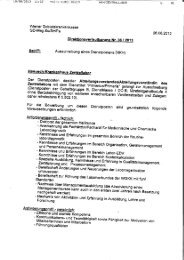Diagnosis and Classification of Diabetes Mellitus
Diagnosis and Classification of Diabetes Mellitus
Diagnosis and Classification of Diabetes Mellitus
You also want an ePaper? Increase the reach of your titles
YUMPU automatically turns print PDFs into web optimized ePapers that Google loves.
<strong>Diagnosis</strong> <strong>and</strong> <strong>Classification</strong><br />
Table 2dCategories <strong>of</strong> increased risk for<br />
diabetes*<br />
FPG 100 mg/dl (5.6 mmol/l) to 125 mg/dl (6.9<br />
mmol/l) [IFG]<br />
2-h PG in the 75-g OGTT 140 mg/dl (7.8<br />
mmol/l) to 199 mg/dl (11.0 mmol/l) [IGT]<br />
A1C 5.7–6.4%<br />
*For all three tests, risk is continuous, extending<br />
below the lower limit <strong>of</strong> the range <strong>and</strong> becoming<br />
disproportionately greater at higher ends <strong>of</strong> the<br />
range.<br />
diabetes has led to more type 2 diabetes in<br />
women <strong>of</strong> childbearing age, the number <strong>of</strong><br />
pregnant women with undiagnosed type 2<br />
diabetes has increased.<br />
After deliberations in 2008–2009, the<br />
International Association <strong>of</strong> <strong>Diabetes</strong> <strong>and</strong><br />
Pregnancy Study Groups (IADPSG), an<br />
international consensus group with representatives<br />
from multiple obstetrical <strong>and</strong><br />
diabetes organizations, including the<br />
American <strong>Diabetes</strong> Association (ADA),<br />
recommended that high-risk women<br />
found to have diabetes at their initial prenatal<br />
visit, using st<strong>and</strong>ard criteria (Table<br />
3), receive a diagnosis <strong>of</strong> overt, not gestational,<br />
diabetes. Approximately 7% <strong>of</strong> all<br />
pregnancies (ranging from 1 to 14%, depending<br />
on the population studied <strong>and</strong><br />
the diagnostic tests employed) are complicated<br />
by GDM, resulting in more than<br />
200,000 cases annually.<br />
CATEGORIES OF INCREASED<br />
RISK FOR DIABETESdIn 1997 <strong>and</strong><br />
2003, The Expert Committee on <strong>Diagnosis</strong><br />
<strong>and</strong> <strong>Classification</strong> <strong>of</strong> <strong>Diabetes</strong> <strong>Mellitus</strong><br />
(1,2) recognized an intermediate group <strong>of</strong><br />
individuals whose glucose levels do not<br />
meet criteria for diabetes, yet are higher<br />
than those considered normal. These people<br />
were defined as having impaired fasting<br />
glucose (IFG) [fasting plasma glucose<br />
(FPG) levels 100 mg/dl (5.6 mmol/l) to<br />
125 mg/dl (6.9 mmol/l)], or impaired glucose<br />
tolerance (IGT) [2-h values in the<br />
oral glucose tolerance test (OGTT) <strong>of</strong><br />
140 mg/dl (7.8 mmol/l) to 199 mg/dl<br />
(11.0 mmol/l)].<br />
Individuals with IFG <strong>and</strong>/or IGT have<br />
been referred to as having pre-diabetes,<br />
indicating the relatively high risk for the<br />
future development <strong>of</strong> diabetes. IFG <strong>and</strong><br />
IGT should not be viewed as clinical<br />
entities in their own right but rather risk<br />
factors for diabetes as well as cardiovascular<br />
disease. They can be observed as<br />
intermediate stages in any <strong>of</strong> the disease<br />
processes listed in Table 1. IFG <strong>and</strong> IGT<br />
are associated with obesity (especially<br />
abdominal or visceral obesity), dyslipidemia<br />
with high triglycerides <strong>and</strong>/or low<br />
HDL cholesterol, <strong>and</strong> hypertension.<br />
Structured lifestyle intervention, aimed<br />
at increasing physical activity <strong>and</strong> producing<br />
5–10% loss <strong>of</strong> body weight, <strong>and</strong><br />
certain pharmacological agents have been<br />
demonstrated to prevent or delay the development<br />
<strong>of</strong> diabetes in people with IGT;<br />
the potential impact <strong>of</strong> such interventions<br />
to reduce mortality or the incidence <strong>of</strong><br />
cardiovascular disease has not been demonstrated<br />
to date. It should be noted that<br />
the 2003 ADA Expert Committee report<br />
reduced the lower FPG cut point to define<br />
IFG from 110 mg/dl (6.1 mmol/l) to 100<br />
mg/dl (5.6 mmol/l), in part to ensure that<br />
prevalence <strong>of</strong> IFG was similar to that <strong>of</strong><br />
IGT. However, the World Health Organization<br />
(WHO) <strong>and</strong> many other diabetes<br />
organizations did not adopt this change in<br />
the definition <strong>of</strong> IFG.<br />
As A1C is used more commonly to<br />
diagnose diabetes in individuals with risk<br />
factors, it will also identify those at higher<br />
risk for developing diabetes in the future.<br />
When recommending the use <strong>of</strong> the A1C<br />
to diagnose diabetes in its 2009 report,<br />
the International Expert Committee (3)<br />
stressed the continuum <strong>of</strong> risk for diabetes<br />
with all glycemic measures <strong>and</strong> did not<br />
formally identify an equivalent intermediate<br />
category for A1C. The group did note<br />
that those with A1C levels above the laboratory<br />
“normal” range but below the diagnostic<br />
cut point for diabetes (6.0 to<br />
,6.5%) are at very high risk <strong>of</strong> developing<br />
diabetes. Indeed, incidence <strong>of</strong> diabetes<br />
in people with A1C levels in this range<br />
is more than 10 times that <strong>of</strong> people with<br />
lower levels (4–7).However,the6.0to<br />
,6.5% range fails to identify a substantial<br />
number <strong>of</strong> patients who have IFG <strong>and</strong>/or<br />
IGT. Prospective studies indicate that<br />
people within the A1C range <strong>of</strong> 5.5–<br />
6.0% have a 5-year cumulative incidence<br />
<strong>of</strong> diabetes that ranges from 12 to 25%<br />
(4–7), which is appreciably (three- to<br />
eightfold) higher than incidence in the<br />
U.S. population as a whole (8). Analyses<br />
<strong>of</strong> nationally representative data from the<br />
National Health <strong>and</strong> Nutrition Examination<br />
Survey (NHANES) indicate that the<br />
A1C value that most accurately identifies<br />
peoplewithIFGorIGTfallsbetween5.5<br />
<strong>and</strong> 6.0%. In addition, linear regression<br />
analyses <strong>of</strong> these data indicate that among<br />
the nondiabetic adult population, an FPG<br />
<strong>of</strong> 110 mg/dl (6.1 mmol/l) corresponds<br />
to an A1C <strong>of</strong> 5.6%, while an FPG <strong>of</strong> 100<br />
mg/dl (5.6 mmol/l) corresponds to an<br />
A1C <strong>of</strong> 5.4% (R.T. Ackerman, personal<br />
communication). Finally, evidence from<br />
the <strong>Diabetes</strong> Prevention Program (DPP),<br />
wherein the mean A1C was 5.9% (SD<br />
0.5%), indicates that preventive interventions<br />
are effective in groups <strong>of</strong> people with<br />
A1C levels both below <strong>and</strong> above 5.9%<br />
(9). For these reasons, the most appropriate<br />
A1C level above which to initiate preventive<br />
interventions is likely to be<br />
somewhere in the range <strong>of</strong> 5.5–6%.<br />
As was the case with FPG <strong>and</strong> 2-h PG,<br />
defining a lower limit <strong>of</strong> an intermediate<br />
category <strong>of</strong> A1C is somewhat arbitrary,<br />
as the risk <strong>of</strong> diabetes with any measure<br />
or surrogate <strong>of</strong> glycemia is a continuum,<br />
extending well into the normal ranges. To<br />
maximize equity <strong>and</strong> efficiency <strong>of</strong> preventive<br />
interventions, such an A1C cut<br />
point should balance the costs <strong>of</strong> “false<br />
negatives” (failing to identify those who<br />
are going to develop diabetes) against<br />
the costs <strong>of</strong> “false positives” (falsely identifying<br />
<strong>and</strong> then spending intervention resources<br />
on those who were not going to<br />
develop diabetes anyway).<br />
Compared to the fasting glucose cutpoint<br />
<strong>of</strong> 100 mg/dl (5.6 mmol/l), an A1C<br />
cutpoint <strong>of</strong> 5.7% is less sensitive but more<br />
specific <strong>and</strong> has a higher positive predictive<br />
value to identify people at risk for<br />
later development <strong>of</strong> diabetes. A large<br />
prospective study found that a 5.7% cutpoint<br />
has a sensitivity <strong>of</strong> 66% <strong>and</strong> specificity<br />
<strong>of</strong> 88% for the identification <strong>of</strong><br />
subsequent 6-year diabetes incidence<br />
(10). Receiver operating curve analyses<br />
<strong>of</strong> nationally representative U.S. data<br />
(NHANES 1999-2006) indicate that an<br />
A1C value <strong>of</strong> 5.7% has modest sensitivity<br />
(39-45%) but high specificity (81-91%)<br />
to identify cases <strong>of</strong> IFP (FPG .100 mg/<br />
dl) (5.6 mmol/l) or IGT (2-h glucose .<br />
140 mg/dl) (R.T. Ackerman, personal<br />
communication). Other analyses suggest<br />
that an A1C <strong>of</strong> 5.7% is associated with<br />
diabetes risk similar to the high-risk participants<br />
in the DPP (R.T. Ackerman, personal<br />
communication). Hence, it is<br />
reasonable to consider an A1C range <strong>of</strong><br />
5.7 to 6.4% as identifying individuals<br />
with high risk for future diabetes <strong>and</strong> to<br />
whom the term pre-diabetes may be applied<br />
if desired.<br />
Individuals with an A1C <strong>of</strong> 5.7–6.4%<br />
should be informed <strong>of</strong> their increased risk<br />
for diabetes as well as cardiovascular disease<br />
<strong>and</strong> counseled about effective strategies,<br />
such as weight loss <strong>and</strong> physical<br />
activity, to lower their risks. As with glucose<br />
measurements, the continuum <strong>of</strong> risk<br />
is curvilinear, so that as A1C rises, the risk<br />
<strong>of</strong> diabetes rises disproportionately.<br />
S68 DIABETES CARE, VOLUME 35, SUPPLEMENT 1, JANUARY 2012 care.diabetesjournals.org




